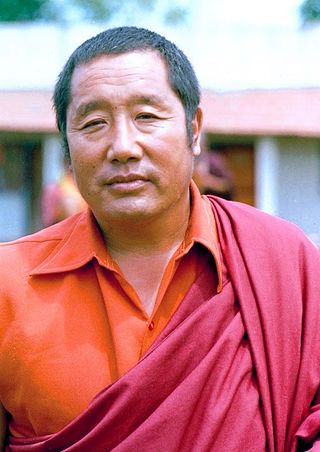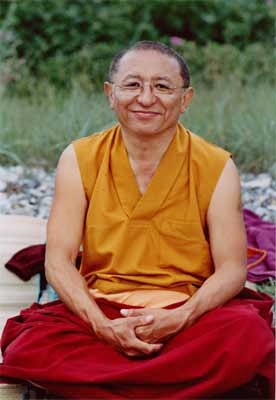A tulku is a distinctive and significant aspect of Tibetan Buddhism, embodying the concept of enlightened beings taking corporeal forms to continue the lineage of specific teachings. The term "tulku" has its origins in the Tibetan word "sprul sku", which originally referred to an emperor or ruler taking human form on Earth, signifying a divine incarnation. Over time, this term evolved within Tibetan Buddhism to denote the corporeal existence of highly accomplished Buddhist masters whose purpose is to ensure the preservation and transmission of a particular lineage.

Tashi Paljor, Dilgo Khyentse Rinpoche was a Vajrayana master, scholar, poet, teacher, and recognized by Buddhists as one of the greatest realized masters. Head of the Nyingma school of Tibetan Buddhism from 1988 to 1991, he is also considered an eminent proponent of the Rime tradition.

Nyingma, often referred to as Ngangyur, is the oldest of the four major schools of Tibetan Buddhism. The Nyingma school is founded on the first lineages and translations of Buddhist scriptures from Sanskrit into Tibetan in the eighth century, during the reign of King Trisong Detsen.

Jamyang Khyentse Wangpo, also known by his tertön title, Pema Ösel Dongak Lingpa, was a teacher, scholar and tertön of 19th-century Tibet. He was a leading figure in the Rimé movement.
In Tibetan Buddhism, Ngöndro refers to the preliminary, preparatory or foundational practices or disciplines common to all four schools of Tibetan Buddhism and also to Bon. They precede deity yoga.

Dzongsar Khyentse Chökyi Lodrö was a Tibetan lama, a master of many lineages, and a teacher of many of the major figures in 20th-century Tibetan Buddhism. Though he died in 1959 in Sikkim, and is not so well known in the West; he was a major proponent of the Rimé movement within Tibetan Buddhism, and had a profound influence on many of the Tibetan lamas teaching today.
Tertön is a term within Tibetan Buddhism meaning a person who is a discoverer of ancient hidden texts or terma. Many tertöns are considered to be incarnations of the twenty five main disciples of Padmasambhava, who foresaw a dark time in Tibet. He and his consort Yeshe Tsogyal hid teachings to be found in the future to benefit beings. A vast system of transmission lineages developed. Scriptures from the Nyingma school were updated by terma discoveries, and terma teachings have guided many Tibetan Bon and Buddhist practitioners.

Chagdud Tulku was a Tibetan teacher of the Nyingma school of Vajrayana Tibetan Buddhism. He was known and respected in the West for his teachings, his melodic chanting voice, his artistry as a sculptor and painter, and his skill as a physician. He acted as a spiritual guide for thousands of students worldwide. He was the sixteenth tülku of the Chagdud line.

Kyabje Dudjom Jigdral Yeshe Dorje was known as Terchen Drodül Lingpa and as Dudjom Rinpoche. He is considered by many Tibetan Buddhists to be from a line of important Tulku lineage, and a renowned Tertön. Per lineage, he was a direct incarnation of both Padmasambhava and Dudjom Lingpa (1835–1904). He was a Nyingma householder, yogi, and a Vajrayana and Dzogchen master. According to his disciple Khenpo Tsewang Dongyal, he was revered as "His Holiness" and as a "Master of Masters".

Kyabjé Drubwang Padma Norbu Rinpoche, 1932 – 27 March 2009, was the 11th throneholder of the Palyul Lineage of the Nyingma school of Tibetan Buddhism, and said to be an incarnation of Vimalamitra. He was widely renowned in the Tibetan Buddhist world as a master of Dzogchen. He was one of a very few teachers left from his generation who received all his training in Tibet under the guidance of what Tibetan Buddhists consider to be fully enlightened teachers.

Kyabje Dungse Thinley Norbu Rinpoche was a major modern teacher in the Nyingma lineage of Tibetan Buddhism, and patron of the Vajrayana Foundation. He was the eldest son of Dudjom Rinpoche, the former head of the Nyingma lineages, and also the father of Dzongsar Jamyang Khyentse Rinpoche and Dungse Garab Rinpoche. His association with the Dudjom Lineage is a long one: he is held to be the incarnation of Tulku Drime Oser, who was one of seven sons of Dudjom Lingpa. He also was considered to be an emanation of Longchen Rabjam, the great 14th-century Nyingma scholar and siddha who composed the Seven Treasuries. He died in California on December 26, 2011, according to the Tibetan Buddhist Lunar Calendar the 2nd day of the 11th month of the Iron Rabbit year. His cremation was held in a public buddhist cremation ceremony in Paro, Bhutan on March 3, 2012, which was attended by several thousand people, including some of Bhutan's royal family.

Patrul Rinpoche (1808–1887) was a teacher and author from the Nyingma school of Tibetan Buddhism.
Orgyen Kusum Lingpa (1934-2009) was a Tibetan terton and Nyingma lineage holder within Tibetan Buddhism. His name means "Holder of the Sanctuary of the Trikaya of Oddiyana Padmasambhava."

Khenchen Palden Sherab Rinpoche, also known as "Khen Rinpoche," was a teacher, a scholar, a lama, and a Dzogchen master in the Nyingma school of Tibetan Buddhism. He was considered by Penor Rinpoche to be one of the most learned living Nyingma scholars. Palden Sherab founded the Orgyen Samye Chokhor Ling Nunnery, the first nunnery in Deer Park (Sarnath).

Kathok Monastery, also transliterated as Kathog, Katok, or Katog, was founded in 1159 and is one of the "Six Mother Monasteries" in Tibet of the Nyingma school of Tibetan Buddhism, built after Samye Monastery. It is located in Payul, Garzê Prefecture, Sichuan, China, in the region traditionally known to Tibetans as Kham.
Khenpo Ngawang Palzang, also known as Khenpo Ngagchung, is considered by the Tibetan tradition to be an emanation of Vimalamitra.

Nyoshül Khenpo Rinpoche, more fully Nyoshül Khenpo Jamyang Dorje, was a Tibetan lama born in the Derge region of Kham.

Chökyi Nyima Rinpoche is a Tibetan Buddhist teacher and meditation master. He is the abbot of Ka-Nying Shedrub Ling Monastery in Kathmandu, Nepal. He is the author of several books, founder of meditation centers around the world, and an international teacher.

Sera Khandro Kunzang Dekyong Wangmo (1892–1940) or Sera Kandro is considered an emanation of Yeshe Tsogyal, and in her lifetime was a Tertön of Tibetan Buddhist Vajrayana, a biographer and autobiographer, and a highly respected teacher. She taught Dudjom Rinpoche, Chatral Rinpoche, and the First Adzom Drukpa, Drodul Pawo Dorje, among other high lamas.
In the Nyingma Tibetan Buddhist Dharma teachings faith's essence is to make one's being, and perfect dharma, inseparable. The etymology is the aspiration to achieve one's goal. Faith's virtues are like a fertile field, a wishing gem, a king who enforces the law, someone who holds the carefulness stronghold, a boat on a great river and an escort in a dangerous place. Faith in karma causes temporary happiness in the higher realms. Faith is a mental state in the Abhidharma literature's fifty-one mental states. Perfect faith in the Buddha, his Teaching (Dharma) and the Order of his Disciples (Sangha) is comprehending these three jewels of refuge with serene joy based on conviction. The Tibetan word for faith is day-pa, which might be closer in meaning to confidence, or trust.















